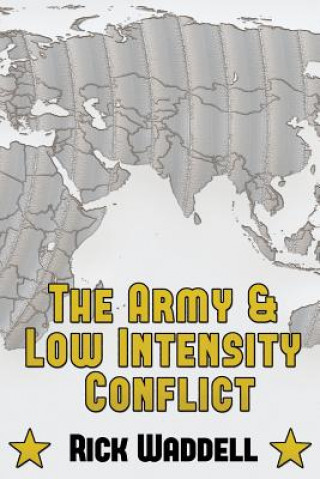
Kód: 08886299
Army and Low Intensity Conflict
Autor Rick Waddell
During the Cold War, given the threat of the Soviet military poised in Eastern Europe, the Army had to be able to wage armored warfare. The fear of low intensity conflict throughout the Cold War was the fear of bleeding to death f ... celý popis
- Jazyk:
 Angličtina
Angličtina - Vazba: Brožovaná
- Počet stran: 322
Nakladatelství: Fortis, 2013
- Více informací o knize

Mohlo by se vám také líbit
-

Dune
262 Kč -

Haunting Adeline
620 Kč -

Berserk Deluxe Volume 2
1092 Kč -

White Nights
90 Kč -

Powerless
260 Kč -

Atomic Habits
493 Kč -

Dune Messiah
183 Kč -

Berserk Deluxe Volume 3
1142 Kč -

One Day
276 Kč -

Berserk Deluxe Volume 1
1115 Kč -

Iron Flame
354 Kč -

Surrounded by Idiots
316 Kč -

Harry Potter and the Prisoner of Azkaban (Minalima Edition)
688 Kč -

Gravity Falls Journal 3
440 Kč -

Heaven Official's Blessing: Tian Guan Ci Fu (Novel) Vol. 1
440 Kč -

The Creative Act
586 Kč -

Dune
268 Kč -

Hunting Adeline
642 Kč -

A Little Life
276 Kč -

Children of Dune
174 Kč -

Heaven Official's Blessing: Tian Guan Ci Fu (Novel) Vol. 2
399 Kč
Darujte tuto knihu ještě dnes
- Objednejte knihu a zvolte Zaslat jako dárek.
- Obratem obdržíte darovací poukaz na knihu, který můžete ihned předat obdarovanému.
- Knihu zašleme na adresu obdarovaného, o nic se nestaráte.
Více informací o knize Army and Low Intensity Conflict
Nákupem získáte 51 bodů
 Anotace knihy
Anotace knihy
During the Cold War, given the threat of the Soviet military poised in Eastern Europe, the Army had to be able to wage armored warfare. The fear of low intensity conflict throughout the Cold War was the fear of bleeding to death from small bites. In this vein low intensity conflict was equivalent to an economy-of-force operation where our adversaries struck at us in our most vulnerable areas - terrorism, subversion, and insurgency. But, the challenge of low intensity conflict transcended the Cold War. The Soviets are gone, but the style of conflict remains: the security environment of the future may look more like the urban hell of Beirut, Sarajevo, or Baghdad where hand-held missiles and crude homemade bombs threaten air and ground movement, and more like the jungles of Vietnam or the mountains of Afghanistan, where the physical and human terrain negates or reduces the effectiveness of heavy weapons and high technology devices. Despite a large number of works that dealt with some aspect of low intensity conflict, none focused exclusively on the evolution of the Army's response to this security challenge. Understanding this evolution is important because the problems of terrorism, insurgency, peacekeeping, and contingency operations - the categories of low intensity conflict - took on new relevance in a world without the Soviet Union. The great bipolar confrontation had, for 45 years, submerged many of the world's ethnic, religious, and economic passions. The end of the Cold War gave these passions a new, violent and bloody freedom. Although interstate conflict remains a threat, many of the aforementioned passions give rise to internal conflicts which require the use of force in non-traditional ways. The Army did not respond well to the challenge in the past, costing thousands of American lives and setting up the only strategic defeat that the United States has suffered. By the early 1990s, the United States government once again determined that it wanted the capability to respond to these challenges. The changes in the early 1990s to the national strategy and the subordinate military strategy placed far greater emphasis on low intensity missions for the Army than had been the case since the early 1960s. Much of the post-Cold War Army would be based in the continental United States, and organized for rapid deployability in response to regional crises. Thus, the greater focus on conflict at the lower end of the spectrum colored the Army's, as well as the nation's, foreign policy abilities in the rest of the decade. Understanding the process of organizational change in the military, then, is necessary to the appropriate management of the Army's mission. If the Army does not prepare well to enact changed national strategy, the costs are quite high in human terms. And, as the defeat in Vietnam demonstrated, the political costs to the nation are quite high, too. We have now engaged in more than a decade of war after the 9-11 attacks, mostly of the low intensity variety. This book sets the stage for understanding the process the Army went through before it entered that decade, and can help us understand how the Army changed during the war.
 Parametry knihy
Parametry knihy
Zařazení knihy Knihy v angličtině Humanities History Military history
510 Kč
- Plný název: Army and Low Intensity Conflict
- Autor: Rick Waddell
- Jazyk:
 Angličtina
Angličtina - Vazba: Brožovaná
- Počet stran: 322
- EAN: 9781937592325
- ISBN: 9781937592325
- ID: 08886299
- Nakladatelství: Fortis
- Hmotnost: 472 g
- Rozměry: 229 × 152 × 18 mm
- Datum vydání: 22. February 2013
Osobní odběr Praha, Brno a 12903 dalších
Copyright ©2008-24 nejlevnejsi-knihy.cz Všechna práva vyhrazenaSoukromíCookies



 Vrácení do měsíce
Vrácení do měsíce 571 999 099 (8-15.30h)
571 999 099 (8-15.30h)